- New Sailboats
- Sailboats 21-30ft
- Sailboats 31-35ft
- Sailboats 36-40ft
- Sailboats Over 40ft
- Sailboats Under 21feet
- used_sailboats
- Apps and Computer Programs
- Communications
- Fishfinders
- Handheld Electronics
- Plotters MFDS Rradar
- Wind, Speed & Depth Instruments
- Anchoring Mooring
- Running Rigging
- Sails Canvas
- Standing Rigging
- Diesel Engines
- Off Grid Energy
- Cleaning Waxing
- DIY Projects
- Repair, Tools & Materials
- Spare Parts
- Tools & Gadgets
- Cabin Comfort
- Ventilation
- Footwear Apparel
- Foul Weather Gear
- Mailport & PS Advisor
- Inside Practical Sailor Blog
- Activate My Web Access
- Reset Password
- Customer Service

- Free Newsletter


Mason 33 Used Boat Review

Beneteau 311, Catalina 310 and Hunter 326 Used Boat Comparison

Maine Cat 41 Used Boat Review

Cheoy Lee Clipper 36 & 42 Used Boat Review

Tips From A First “Sail” on the ICW

Tillerpilot Tips and Safety Cautions

Best Crimpers and Strippers for Fixing Marine Electrical Connectors

Thinking Through a Solar Power Installation

Stopping Mainsheet Twist

Working with High-Tech Ropes

Getting a Clue for the Blown-Out Clew

Monel Seizing Wire is Worth the Extra Cost

Fuel Lift Pump: Easy DIY Diesel Fuel System Diagnostic and Repair

Ensuring Safe Shorepower

Sinking? Check Your Stuffing Box

The Rain Catcher’s Guide

Boat Maintenance for the Technically Illiterate: Part 1

Whats the Best Way to Restore Clear Plastic Windows?

Mastering Precision Drilling: How to Use Drill Guides

Giving Bugs the Big Goodbye

Galley Gadgets for the Cruising Sailor

Those Extras you Don’t Need But Love to Have

UV Clothing: Is It Worth the Hype?

Preparing Yourself for Solo Sailing

How to Select Crew for a Passage or Delivery

Preparing A Boat to Sail Solo

On Watch: This 60-Year-Old Hinckley Pilot 35 is Also a Working…

On Watch: America’s Cup

On Watch: All Eyes on Europe Sail Racing

Dear Readers

Chafe Protection for Dock Lines
- Sailboat Reviews
Cabo Rico 38: Used Boat Survey
Still going strong after more than 20 years, this bill crealock design is much admired for its strength, seakeeping ability, and teak joinerwork. too bad only a privileged few can afford one..

If we made a short list of traditional-looking cruising boats with trailboards and oodles of teak that dreamy-eyed readers most want to know about, the Cabo Rico 38 would be near the top. Others of her ilk, like the Canadian-built Gozzard 37 and 44, also draw much interest. But all that good detail in wood doesn’t come cheap. So many of us walk the boat show docks muttering, “Some day…”
History Cabo Rico has a rather unusual genesis, starting as it did as the hobby of one John Schofield, manager of a British automotive plant in San Jose, Costa Rica during the 1960s. A keen yachtsman, Schofield apparently saw no reason why his relegation to Latin America should quash his love of sailboats, so he began building boats in the corner of Leyland’s Range Rover facility. His first boats came out the door in 1965. By 1971 he had introduced the Tiburon 36 ketch, designed by Californian Bill Crealock. Six years later, in 1977, came the Cabo Rico 38, with which we are here concerned.
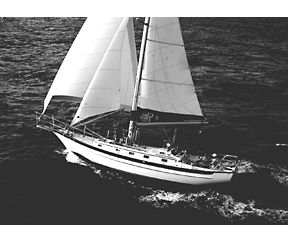
Edi and Fraser Smith bought the company in 1987 and have expanded operations since. The Cabo Rico line now includes models from 34 to 50 feet, all with pilothouse options except the baby of the fleet.
In 1992 the Smiths bought David Walters Custom Yachts. If you know your fiberglass boat history, you’ll recall that David Walters is the yacht broker who in 1975 co-founded Shannon Yachts with Walter Schulz in Portsmouth, Rhode Island. The Cambrias, envisioned by Walters as elegant competitors to Nautor Swan, Baltic, etc., now include the 40, 44/46, 48 and 52.
The Cabo Rico 38, however, was for years the backbone of the company. Its 24-year production run now rivals long-lived hall of famers like the Hinckley Bermuda 40. Naturally, the materials and methods used to build the 38 have evolved over the years.
About 190 38s have been built, but none in the past three years. The company says, however, that there seems to be a resurgence of interest in this particular model. Most recent sales have been for the company’s larger models—the 42 and 45.
The Design The Cabo Rico 38 is a traditional full- keel design with keel-hung rudder. The forefoot has been cut away somewhat to reduce wetted surface and improve handling. This is a trait of all Cabo Ricos, regardless of designer—Chuck Paine did the 40/42; the rest are by W.I.B. Crealock.
When evaluating any boat on paper, one of the first things you want to do is check the displacement/length ratio (D/L) and the sail area/displacement ratio (SA/D). These two numbers tell a lot about how the boat will perform, as well as its carrying capacity (generally, the higher the D/L number, the more volume inside the hull).
The Cabo Rico 38’s D/L is 375 and its SA/D is 16.3. This makes the boat moderately heavy, with a mediumsized sailplan—about what you’d expect for a traditional, seakindly ocean cruiser. She has enough power to make decent passage speeds when the wind is up, but she won’t be a great light-air performer, especially laden for cruising.
When viewed in profile, the clipper bow is prominent. This style is characterized by concavity, so that the bow seems to arch out over the water like a dolphin. The 38’s bow is adorned with real teak trailboards, not molded fiberglass, a hideous perversion seen on some boats.
There’s quite a bit of spring to the sheer line, with the low spot in the classic location, about two-thirds or so of the way aft.
The conventional counter stern looks right. It has just a little overhang and is moderately broad. Many modern cruisers carry beam much farther aft than the Cabo Ricos; this increases cockpit space and stowage, but can present downwind handling problems which are avoided by the Cabo Rico’s conservative approach.
The cabin has a fairly low profile, with small opening portlights. The proportions are good; few design elements look worse than a cabin that’s too tall for the boat; that is, out of proportion to hull length and freeboard.
The rig is a cutter, which means the mast is located somewhat farther aft than on a sloop. It’s keel-stepped, so the designer had to plan where it would be in relation to the interior. As on many boats, the 38’s mast passes through the dinette table, which is perhaps unavoidable, but it does obstruct your view of your tablemates.
The 38, like most other Cabo Ricos, is available with a pilothouse. But Cabo Rico’s sales manager, Ann Stirlen, says that while many clients give strong initial consideration to the comforts of all-weather helm stations, nearly all in the end stick with trunk cabin models.
Construction The hull and deck of the 38 are, of course, fiberglass, and both are cored with end-grain balsa wood. (The larger Cabo Ricos are cored with Airex and/or Corecell.) Interestingly, the hull core is not centered between the two skins, but added inside to what is basically a solid fiberglass hull, then covered with a thin interior skin. Fraser Smith said the balsa is not needed structurally, but is added for insulation purposes. The company publishes its lamination schedule, which we think ought to be standard practice for all builders, but rarely is.
The deck coring is removed in areas where hardware will be attached, and in a recent change, deck hardware now is installed by embedding stainless steel plates in the laminate, drilled and tapped so that hardware can be fastened by one person topsides.
We don’t have experience with this method of hardware attachment and wonder about strength when, say, someone falls against a stanchion and its base is wrenched. Could the plate fracture the surrounding glass? What happens when threads get stripped? We don’t know. In any event, it’s a neat installation that eliminates washers, nuts, and backing plates, probably reduces leaks, and certainly cleans up the underdeck area.
Early models were built with alternating layers of mat and woven roving, but there have been, as one would expect, many advances in the making of fiberglass fabrics. Today, Cabo Rico primarily uses 1708 and 1808 (8-ounce mat stitched to directional rovings) fabrics, along with vinylester resin for the first three layers (two of which are mat) inside the isophthalic gel coat. This helps prevent osmotic blistering.
The keel is part of the hull mold and in early boats the ballast was iron. According to Fraser Smith, ballast was switched to lead in the last 40 or 50 boats. There are seven separate castings, set in the keel cavity, and then the voids are filled with resin. The ballast is glassed over.
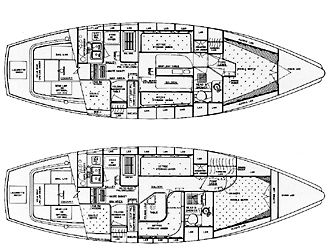
The hull is stiffened with U-channel fiberglass beams glassed to the hull. A fiberglass subfloor is placed over the beams, and then a solid teak and holly sole.
Portlights have been changed and are now made by New Found Metals; no outside fasteners are visible.
The interior has no pan, but is built up of plywood and solid teak or other hardwood. Smith says they’ve done a number of boats recently in the traditional Maine motif with white panels bordered by varnished mahogany trim. You can have whatever other wood you want—maple, ash, cherry…
Fiberglass moldings are used for the shower, engine beds, and icebox, which are good places to use fiberglass rather than wood.
Twenty years ago, teak decks were much desired. Cheoy Lee Shipyards of Hong Kong, one of the first “offshore” yacht builders to sell into the US (and thereby an ancestral forebear of Cabo Rico) sold a lot of boats to the US with teak decks.
Teak planks are generally screwed through the fiberglass deck skin and into a plywood core. The screws are countersunk and the heads covered with bungs. Over the years, however, the deck and bungs expand and shrink and begin to move. The glue holding the bungs ages and cracks. Eventually, water enters around the bung, seeps down along the screw, and into the plywood core. When the plywood begins to rot, the cure can cost you 25 grand or so.
Also, as Ann Stirlen points out, teak decks add considerable weight to a boat, weight that is fairly high off the water.
While Cabo Rico will still add teak decks to any boat, they haven’t done so in several years. Owners now prefer lower-maintenance fiberglass decks with molded nonskid more than the warm beauty of wood.
The hull/deck joint occurs at the bulwark and is bedded with 3M 5200 and through-bolted on 6-inch centers.
Tanks are fiberglass, but not integral, meaning they are molded separately and are not part of the hull. The bridge structure that supports the mast also incorporates the holding tank. Fuel capacity is 65 gallons; fresh water is 190 gallons.
The original engine was the excellent Perkins 4:108; that’s been replaced by the ubiquitous Yanmar—a 56-hp. model. One owner completing our Boat Owner’s Questionnaire, however, said his 38 is equipped with a 70-hp Chrysler diesel built by Nissan.
While most owners would seem to agree with the owner of a 1984 model who said his boat is “designed and built for offshore cruising,” the owner of a 1980 model complained that “stanchion bolts are inaccessible, bulkheads aren’t all tabbed securely to the cabin sides and overhead, and all through-hulls aren’t bonded.”
Another 1980 owner said that while his boat is “overbuilt,” its one flaw was a teak cockpit sole screwed into plywood, which “completely rotted from water penetration.”
Despite these and a few other gripes, generally of early models, most owners agree that the 38 is strongly built and “of excellent quality throughout.”
Interior Early brochures show two basic accommodation plans for the 38. Plan A shows the usual V-berth forward, head and hanging locker just aft of that, and amidships two settees with dinette table on centerline. The U-shaped galley is in the port quarter and to starboard of the companionway is a double berth.
Plan B is the same except for a rather unusual L-shaped dinette and a double berth forward offset to starboard. One leg of the dinette deadends at a bulkhead, making it appear that persons sitting there are more or less trapped by the table, which also runs to the bulkhead.
Headroom is at least 6′ 2-1/2″ and berth lengths generally run 6′ 6″.
There are currently seven accommodation plans available—or you can have an entirely custom layout if you’re willing to pay for it. One of the more common plans shows a V-berth forward, L-shaped galley to port (with access around both sides of the table), settee to starboard, U-shaped galley in the same port quarter area, and an aft stateroom in the starboard quarter area.

The aft double berth is larger than in earlier models, extending behind the companionway ladder. This is possible because the engine has been moved forward under the galley sink and dinette seat. Not only does this open up a lot of space under the cockpit, it makes engine access somewhat easier (by removing parts of the galley and seat), and also moves this heavy piece of machinery closer to the boat’s center of gravity. This should translate into less of a tendency to hobby-horse in choppy seas.
As mentioned earlier, Cabo Rico does not use a fiberglass pan to form engine beds, berth flats, galley structure, etc. Instead, the interior is built up of plywood tabbed to the hull, which creates a sort of monocoque structure. Done properly it’s very strong. There are many advantages to all-wood interiors, including better access to all parts of the hull (you can cut or smash your way into any compartment if you need to stop a leak caused by a collision below the waterline); and superior thermal and acoustic insulation (boats with wood interiors are quieter and dryer than boats with fiberglass pan interiors). The problem is that all-wood interiors require many man-hours to assemble, which dramatically jacks up the price. Indeed, most boats with all-wood interiors nowadays are at least semi-custom yachts, priced well above most production boats.
Performance During a test sail of the Cabo Rico 38 we found the boat to be well mannered, with few vices. With a bit of wind, she moves nicely. Again, she wasn’t designed to drift around buoys but to strut her stuff in offshore conditions. The moderately heavy displacement makes the 38 feel secure in the water; it doesn’t jump around like lighter-displacement boats. And the full keel gives it good directional stability; that is, it enables the boat to steer a straight line without a lot of attention to the helm.
The flip side of this, of course, is that full keels generally don’t allow boats to point as high as boats with fin keels. So, like everything else with yacht design, there are trade-offs. And while we are believers in the advantages of full keels—protection in collisions, directional stability, ability to careen boat for repairs, absence of worrisome keel bolts in most boats—we also well appreciate the ability of fin keel boats to point higher. At least in coastal sailing, pointing high can get you home faster, and faster is safer. Offshore, it’s less relevant.
Owner estimations of their boats’ performance relative to other designs vary: While the owner of a 1979 model says of his, “Really not a racing boat,” the owner of a 1984 model boasts that he can “consistently catch and pass supposedly ‘fast’ boats.” Most agree that speed is “average,” improving to “fast” in higher wind strengths.
Of more interest perhaps than speed is seakeeping ability, and here the 38 excels. Owner after owner notes how well the 38 handles in severe conditions: The rudder doesn’t stall, forcing uncontrolled round-ups; heel is easily reduced because of the cutter rig; and motion is more comfortable than on flatter-bottom boats. “Very solid and safe,” wrote one owner.
Conclusion The Cabo Rico 38 is now a near classic. At 24 years of age, the design still looks great, thanks to the fine eye of Bill Crealock. And thanks to dedicated owners, the 38 has been continually refined so that there are few flaws left. If you find one, the company will work with you to eliminate it.
The price of a fully equipped 38 in 1981 was about $115,000. Today, the base price is $299,000, with most boats going out the door closer to $320,000.
It’s always difficult to say whether an expensive boat is a good deal or not. The Used Boat Price History shown on the opposite page shows that a 1984 Cabo Rico 38 was a good investment, but when buying new, all you can do is compare prices among other boats of roughly the same size (considering their intended uses) and make your own judgment. For reference, a Hunter 380 starts at around $160,000, an Island Packet 380 at about $265,000, and a Tartan 3700 with wood interior at around $275,000.
Contact- Cabo Rico Custom Yachts, Inc. 2258 S.E. 17th Street Ft. Lauderdale, FL 33316; 954/462-6699; www.caborico.com .
Also With This Article Click here to view “Used Boat Price History.” Click here to view “Owner Comments.”
RELATED ARTICLES MORE FROM AUTHOR
Leave a reply cancel reply.
Log in to leave a comment
Latest Videos

The Perfect Family Sailboat! Hunter 27-2 – Boat Review

Pettit EZ-Poxy – How to Paint a Boat

The Boat From True Spirit – Sparkman & Stephens


Top 5 Boat Hacks – Boat Maintenance Tips and Tricks
Latest sailboat review.

- Privacy Policy
- Do Not Sell My Personal Information
- Online Account Activation
- Privacy Manager
Great choice! Your favorites are temporarily saved for this session. Sign in to save them permanently, access them on any device, and receive relevant alerts.
- Sailboat Guide
Cabo Rico 38
Cabo Rico 38 is a 41 ′ 0 ″ / 12.5 m monohull sailboat designed by William Crealock and built by Cabo Rico starting in 1977.

Rig and Sails
Auxilary power, accomodations, calculations.
The theoretical maximum speed that a displacement hull can move efficiently through the water is determined by it's waterline length and displacement. It may be unable to reach this speed if the boat is underpowered or heavily loaded, though it may exceed this speed given enough power. Read more.
Classic hull speed formula:
Hull Speed = 1.34 x √LWL
Max Speed/Length ratio = 8.26 ÷ Displacement/Length ratio .311 Hull Speed = Max Speed/Length ratio x √LWL
Sail Area / Displacement Ratio
A measure of the power of the sails relative to the weight of the boat. The higher the number, the higher the performance, but the harder the boat will be to handle. This ratio is a "non-dimensional" value that facilitates comparisons between boats of different types and sizes. Read more.
SA/D = SA ÷ (D ÷ 64) 2/3
- SA : Sail area in square feet, derived by adding the mainsail area to 100% of the foretriangle area (the lateral area above the deck between the mast and the forestay).
- D : Displacement in pounds.
Ballast / Displacement Ratio
A measure of the stability of a boat's hull that suggests how well a monohull will stand up to its sails. The ballast displacement ratio indicates how much of the weight of a boat is placed for maximum stability against capsizing and is an indicator of stiffness and resistance to capsize.
Ballast / Displacement * 100
Displacement / Length Ratio
A measure of the weight of the boat relative to it's length at the waterline. The higher a boat’s D/L ratio, the more easily it will carry a load and the more comfortable its motion will be. The lower a boat's ratio is, the less power it takes to drive the boat to its nominal hull speed or beyond. Read more.
D/L = (D ÷ 2240) ÷ (0.01 x LWL)³
- D: Displacement of the boat in pounds.
- LWL: Waterline length in feet
Comfort Ratio
This ratio assess how quickly and abruptly a boat’s hull reacts to waves in a significant seaway, these being the elements of a boat’s motion most likely to cause seasickness. Read more.
Comfort ratio = D ÷ (.65 x (.7 LWL + .3 LOA) x Beam 1.33 )
- D: Displacement of the boat in pounds
- LOA: Length overall in feet
- Beam: Width of boat at the widest point in feet
Capsize Screening Formula
This formula attempts to indicate whether a given boat might be too wide and light to readily right itself after being overturned in extreme conditions. Read more.
CSV = Beam ÷ ³√(D / 64)
From BlueWaterBoats.org :
Cabo Rico started building their sturdy boats from a corner of British Leyland’s Rover assembly plant in Costa Rica. Among their success stories has been the Cabo Rico 38 which has won a reputation for legendary soft motion and stout offshore performance. The design came from Bill Crealock who had previously designed the Tiburon 36 for Cabo Rico. Not many 36s were built but the 38 on the other hand found popularity in a time when Taiwanese manufacturers were beginning to dominate the US market.
The lines of the Cabo Rico 38 are timeless with a full keeled underbody which follows the design lineage of Crealock’s Tiburon. She’s configured as a true cutter with a bowsprit mounted foresail. Her sheerline is sweet which swings low (as is often the case for older seaworthy designs), with traditional trailboards and teak trim.
The construction is a balsa cored deck paired with a thick skinned balsa sandwich hull. Ballast is internal and changed from iron to lead at around hull 40. The mast is keel stepped. The Costa Rican craftsmen take tremendous pride in the quality of work, and it shows with the spectacular honey colored teak interiors that define these yachts. In fact on older versions, it is hard to find a single spot of gelcoat down below. While on most engine access is through the companionway, the engine location was moved forward on recent models to underneath the centerline galley.
Costa Rican craftsmen hand laid the first hull in 1977, and from there Cabo Rico Custom Yachts has delivered hulls are a steady clip. In fact for a long time, Cabo Rico was a one-boat manufacturer pumping out the 38 with an incredible variety of configurations. You name it, and a 38 will have a layout to suit: two heads, single cabin, v-berth, and so forth. In 1990, they introduced a popular pilothouse version.
There have been over 200 boats built to date, the last hull was built in 2005. Cabo Rico is currently reorganizing according to legal fillings in the state of Florida, USA.
Buyers Notes
Teak decks were common on 1980’s and earlier models. As with any screwed down teak decks, these can be prone to leaking.
Links, References and Further Reading
» Cabo Rico 38 , John Kretschmer, Used Boat Notebook » Cabo Rico 38, Earl R Hinz, Seatrials » Cabo Rico 38 Review , Richard Jordan, Waves
Embed this page on your own website by copying and pasting this code.
Discover Related Sailboats

9 Best Used Sailboats
They may take a little elbow grease and require a few new parts, but here’s a look at nine of the best cruising sailboats that can sail ...

Blue Water Boats
This collection of capable blue water boats features time-tested sailboats with rich histories.

Pacific Seacraft Crealock 37
Bayfield 36/40.

- About Sailboat Guide
©2024 Sea Time Tech, LLC
This site is protected by reCAPTCHA and the Google Privacy Policy and Terms of Service apply.
- Types of Sailboats
- Parts of a Sailboat
- Cruising Boats
- Small Sailboats
- Design Basics
- Sailboats under 30'
- Sailboats 30'-35
- Sailboats 35'-40'
- Sailboats 40'-45'
- Sailboats 45'-50'
- Sailboats 50'-55'
- Sailboats over 55'
- Masts & Spars
- Knots, Bends & Hitches
- The 12v Energy Equation
- Electronics & Instrumentation
- Build Your Own Boat
- Buying a Used Boat
- Choosing Accessories
- Living on a Boat
- Cruising Offshore
- Sailing in the Caribbean
- Anchoring Skills
- Sailing Authors & Their Writings
- Mary's Journal
- Nautical Terms
- Cruising Sailboats for Sale
- List your Boat for Sale Here!
- Used Sailing Equipment for Sale
- Sell Your Unwanted Gear
- Sailing eBooks: Download them here!
- Your Sailboats
- Your Sailing Stories
- Your Fishing Stories
- Advertising
- What's New?
- Chartering a Sailboat
- Cruising Yachts 35' to 40'
- Cabo Rico 38
The Cabo Rico 38 Sailboat Specs & Key Performance Indicators
The Cabo Rico 38, a heavy displacement aft-cockpit cutter, was designed by Bill Crealock & Dennis Garrett and built in Costa Rica by Cabo Rico Custom Yachts Inc.
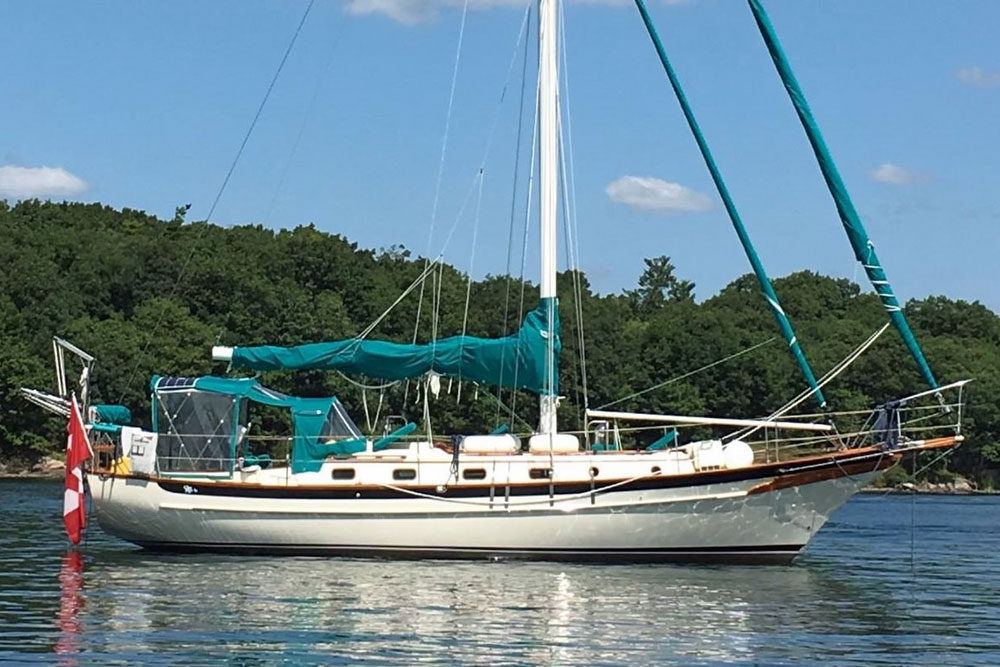
Published Specification for the Cabo Rico 38
Underwater Profile: Long keel
Hull Material: GRP (Fibreglass)
Length Overall: 38'0" ( 11.6m)
Waterline Length: 29'3" ( 8.9m)
Beam: 11'6" ( 3.5m)
Draft: 5'0" ( 1.5m)
Rig Type: Cutter
Displacement: 21,000lb (9,525kg)
Designer: Bill Crealock & Dennis Garrett
Builder: Cabo Rico Custom Yachts ( Costa Rica)
Year First Built: 1970
Number Built: 200
Published Design Ratios for the Cabo Rico 38
1. Sail Area/Displacement Ratio: 20.5
2. Ballast/Displacement Ratio: 37.1
3. Displacement/Length Ratio: 375
4. Comfort Ratio: 39.4
5. Capsize Screening Formula: 1.7
read more about these Key Performance Indicators...
Summary Analysis of the Design Ratios for the Cabo Rico 38
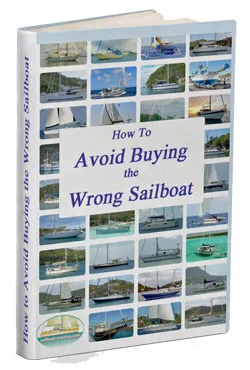
1. A Sail Area/Displacement Ratio of 20.5 suggests that, in the right hands, the Cabo Rico 38 will have enough performance to leave most other sailboats of similar waterline length well astern.
2. A Ballast/Displacement Ratio of 37.1 means that a sailboat like the Cabo Rico 38 (which doesn't have a stiffness-enhancing bulb keel), is likely to benefit from being reefed early to keep her sailing upright in a moderate breeze.
3. A Displacement/Length Ratio of 375, tells us the Cabo Rico 38 is firmly in the ultra-heavy displacement category. Load her up as much as you like and her performance will be hardly affected, not that it was ever startling. Few if any sailboats are built to this displacement category these days - but they remain popular with some long-distance sailors.
4. Ted Brewer's Comfort Ratio of 39.4 suggests that crew comfort of a Cabo Rico 38 in a seaway is similar to what you would associate with the motion of a moderate bluewater cruising boat - a predictable and acceptable motion for most seasoned sailors.
5. The Capsize Screening Formula (CSF) of 1.7 indicates that a Cabo Rico 38 would be a safer choice of sailboat for an ocean passage than one with a CSF of more than 2.0.
Cruisers' Questions about this Sailboat...
What is the history of Cabo Rico Custom Yachts?
The company was founded in 1965 by John Schofield, a British manager of a Leyland automotive plant in San Jose, Costa Rica, who started building power boats as a hobby.
- In the early 1970s, the company launched its first sailboat, the Tiburon 36, a ketch designed by Bill Crealock;
- In 1977, the Tiburon 36 evolved into the Cabo Rico 38, a cutter that became the company's most popular and iconic model;
- In 1983, the company opened a sales office in Fort Lauderdale, Florida, and expanded its dealer network to Europe and Asia;
- In 1987, the company was bought by Fraser and Edi Smith, two Canadians who introduced new models and improved the quality and design of the boats;
- In 1992, the company acquired David Walters Custom Yachts, which produced the Cambria line of luxury sailboats;
- In the 1990s and 2000s, the company collaborated with other designers such as Mark Ellis and Chuck Paine to create new models ranging from 34 to 56 feet, including pilothouse versions;
- In 2005, the company entered a Cabo Rico 56 in the Trans Pacific race and achieved an impressive second place in its class;
- In 2010, the company faced financial difficulties and filed for bankruptcy protection;
- In 2014, the company was reorganized and resumed production under new management.
Who designed the Cabo Rico 38?
The Cabo Rico 38 was designed by William (Bill) Crealock, a renowned naval architect who also designed the Tiburon 36, the Pacific Seacraft 34 and 37, and many other cruising boats.
When and where was the Cabo Rico 38 built?
The Cabo Rico 38 was built by Cabo Rico Custom Yachts in Costa Rica, starting from 1977 until 2005. About 200 hulls were produced in total.
What are the main features of the Cabo Rico 38?
The Cabo Rico 38 is a traditional full-keel cutter with a bowsprit, a low sheerline, and a lot of teak trim. It has a balsa-cored deck and hull, a keel-stepped mast, and an internal ballast. It is known for its strength, seakindliness, and quality craftsmanship.
What are the different layouts and options available for the Cabo Rico 38?
The Cabo Rico 38 has been built with a variety of configurations to suit different preferences and needs. The standard layout has two cabins, one head, and a U-shaped galley to starboard. Some models have two heads, one forward and one aft, or a single cabin with more storage space. The salon can have either a straight settee or an L-shaped dinette to port. In 1990, a pilothouse version was introduced, with an enclosed steering station and more headroom.
What are some of the common upgrades and modifications done to the Cabo Rico 38?
Some of the common upgrades and modifications done to the Cabo Rico 38 include replacing the original Perkins engine with a more reliable Yanmar or Beta engine, adding solar panels, wind generators, or watermakers for more self-sufficiency, installing roller furling systems or electric winches for easier sail handling, upgrading the electronics and navigation equipment, and adding davits, arches, or dinghy hoists for more convenience.
What are some of the pros and cons of owning a Cabo Rico 38?
Some of the pros of owning a Cabo Rico 38 are:
- It is a well-built and well-designed boat that can handle any weather conditions;
- It has a beautiful and cozy interior with lots of teak joinery and fine details;
- It has a loyal and supportive owners' association that can provide advice and assistance.
Some of the cons of owning a Cabo Rico 38 are:
- It is an expensive boat to buy and maintain, especially if it needs major repairs or restoration;
- It is not very fast or responsive in light winds or tight quarters;
- It has limited headroom and storage space compared to some newer designs.
The above answers were drafted by sailboat-cruising.com using GPT-4 (OpenAI’s large-scale language-generation model) as a research assistant to develop source material; to the best of our knowledge, we believe them to be accurate.
Other sailboats in the Cabo Rico range include:
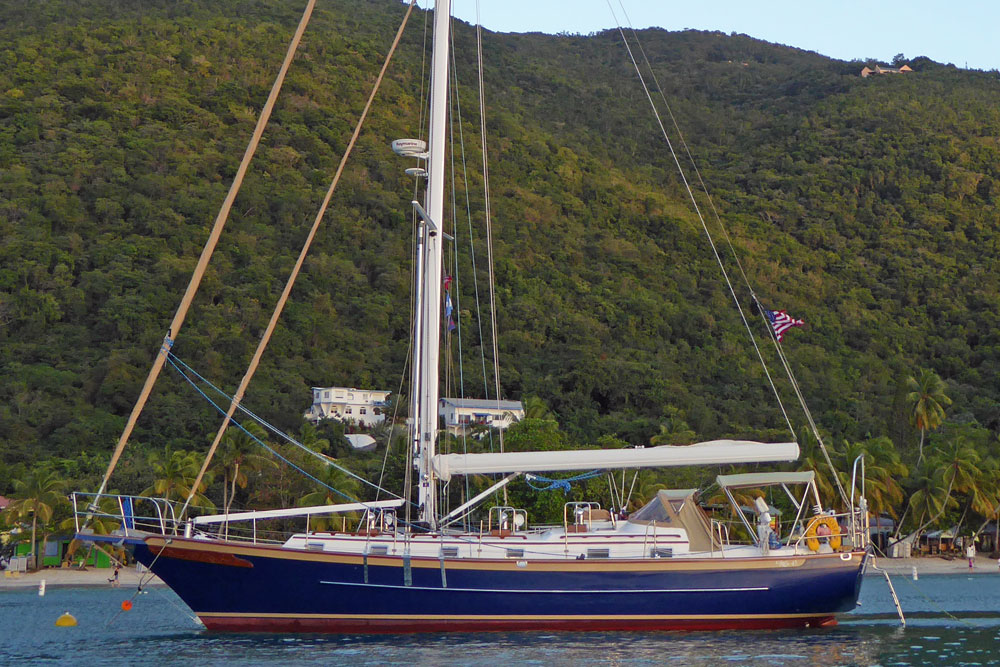
Recent Articles
GENERIC KPI Template
Aug 25, 24 07:21 AM
Gulfstar Hirsch 45 Sailboat Specs & Key Performance Indicators
Aug 25, 24 07:19 AM
Nicholson 35 Sailboat Specs & Key Performance Indicators
Aug 24, 24 02:27 PM
Here's where to:
- Find Used Sailboats for Sale...
- Find Used Sailing Gear for Sale...
- List your Sailboat for Sale...
- List your Used Sailing Gear...
Our eBooks...

A few of our Most Popular Pages...

Copyright © 2024 Dick McClary Sailboat-Cruising.com

List of All Cabo Rico Models

Chuck Paine 42

New Boat Review: The Cabo Rico 34 Underway / Construction / Conclusion
by Captain Thom Burns
I had seen the Cabo Rico 38 at the Annapolis Boat Show where its beautiful lines and long lines to view it impressed me. As Gunnar and I approached the Cabo Rico 34, I noticed how strikingly beautiful the boat actually is. It�s lines, ports, cutter rig, and wood all point to a traditional boat but its not quite that way. The width of the boat, the shape of the stern, the stern rail seats and the cut-away full keel which I knew was below the forward quarter of the boat indicate a modern flare. The designer,W.I.B. Crealock, has tried to provide enough volume for comfort and to add seakindly performance.
When you step into the cockpit there is just enough teak for elegance. This particular boat has a green dodger and canvas covers which accent both the teak and the cream colored hull nicely. The seats are deep and high for comfort. The transom is closed for offshore. Looking forward on deck I noticed the quality hardware and the large dorade vents built in boxes with rails around them to protect them and provide an extra handhold if needed. Below decks this same vent has an adjustable, sliding, offset opening, one of many small but important details for the offshore cruiser. The decks and coach roof are uncluttered. The foredeck is large for a 34 foot boat and the bowsprit extends another three plus feet. Looking down you�ll notice how fine the bow entry is on this relatively wide beam of eleven feet which is carried way aft. From the cockpit you must step up to descend the companionway ladder, another offshore detail.
As you descend the ladder the steps on both sides are cantilevered for easy use when heeled. The wood is a lighter honey colored golden teak of Costa Rica throughout. The U-shaped galley is complete with a stainless steel double sink, two burner gas stove with oven, hot and cold pressure water, a six cubic foot icebox with refrigeration and plenty of lockers and drawers for incidentals. Five Lewmar hatches, the two dorade vents mentioned earlier, and eight opening ports provide ventilation and light. The hull and deck are completely insulated. It was in the high eighties during the day when I was aboard. Many boats would have been like an oven. The Cabo Rico was not. It freshened and cooled in a few minutes with the opening of half the ports and hatches.
The boat has two full double sleeping cabins, one fore, the other aft to starboard. A third double pulls out using a shelf under the settee. Access to storage under the settees is not by pulling cushions up, sliding a plywood cover off and digging into the void, it is by a drawer which pulls out. The doors and cabinetry are solid teak with fine joinery. Even the hanging lockers are vented. The nav table is starboard across from the galley facing aft. This is a very fine station for a thirty-four footer. The vertical panels forward and outboard of the station fold down for access to the electrical boards.
This boat moves really well. We routinely sailed half the true wind speed in a cut-away full keel boat weighing 15,500 lbs.! Its pointing ability is surprising. I would say 33 to 34 degrees apparent was about right. The fore triangle is relatively large for a cutter permitting the use of large lightweight headsails for an extra turn of speed.
This is not a boat you would want to get into a tacking dual with on the race course because with all its weight it powers up slowly. But for a seakindly, smooth ride across vast stretches of the Great Lakes and beyond it could be a cruiser�s dream.
Construction
Cabo Rico uses an elaborate mast step bridge which elevates the mast butt to the dry cabin sole. This allows for an effective keel stepped mast while never allowing the mast butt to come into contact with potentially corrosive bilge water. The bridge itself is of heavy fiberglass laminate in a crisscross pattern, with a half inch aluminum plate laminated into the top covering fiberglass platform. The solid teak and holly sole is epoxied to the covering platform giving a uniform finished area to which the mast step is through bolted. The void is used for the holding tank.
The cabin sole or floor construction on this boat is elaborate. All floor stringers transfers and sub-flooring are solid fiberglass. The solid teak and holly sole is attached with epoxy glue. There is no area of the bilges and substructure that is wood or that can rot under any conditions.
While I was poking around the bilges I found a complete grounding system using heavy industrial wire and connections and a totally encased keel. You could actually reach things under the engine as well as on all sides. This boat is overbuilt by production boat standards from the keel up. I would recommend using the design and construction detail of the Cabo Rico as a good comparison model when shopping boats.
This boat will satisfy its owners in so many ways. It will sail the Great Lakes and oceans of the world in splendid, seakindly and most importantly in a seaworthy manner. It�s built forever, place it in your sailing trust fund. It would surely make an elegant, nautical B & B on Pier 39 in San Francisco. As Gunnar said, one of the main differences in construction and details is the hours Cabo Rico can afford to devote to building the boat from their base in Costa Rica. The company claims they put more hours into building the hull than many builders put into building their entire boat. I believe them. This boat must be seen to be fully appreciated. After you see it your dreams will be rekindled. Clear Great Lakes waters, Caribbean emerald reefs and crystal, pacific lagoons will beckon you as it did Leo Ramer, a novice at 63 who bought his first boat, a Cabo Rico 34, and set out on an extended trip that helped him start living fully again after a personal tragedy.
Captain Thom Burns publishes Northern Breezes and Sailing Breezes.
Cabo Rico Yachts
GUNNAR�S YACHT & SHIP, P.O. Box 35, Racine, WI 53401-0035 , (262) 639-0238 .
CABO RICO YACHTS, INC., 2258 SE 17th St., Ft. Lauderdale, FL 33316, 954-462-6699 .
All contents are copyright (c) 1997 by Northern Breezes, Inc. All information contained within is deemed reliable but carries no guarantees. Reproduction of any part or whole of this publication in any form by mechanical or electronic means, including information retrieval is prohibited except by consent of the publisher.
- Register / Login
A password will be e-mailed to you
Reset Password

CABO RICO 42 PILOT
More information, image gallery, floor plans.
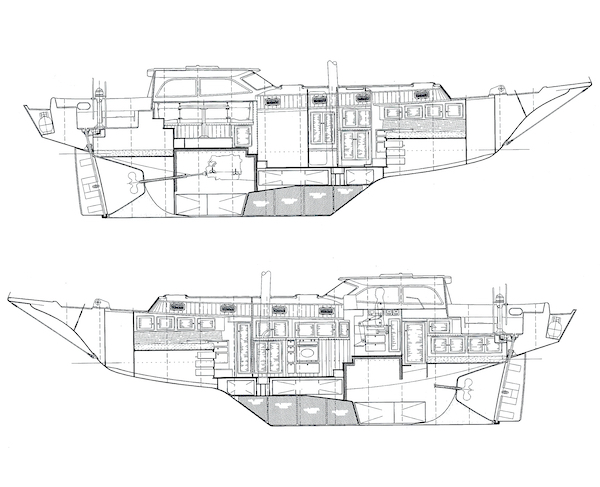
Use the form below to contact us!
Cabo rico 45
The cabo rico 45 is a 45.01ft cutter designed by william crealock and built in fiberglass by cabo rico (cr) since 1995., 8 units have been built., it accomodates 6 people in 2 cabins plus salon..
The Cabo rico 45 is a heavy sailboat which is a good performer. It is stable / stiff and has an excellent righting capability if capsized. It is best suited as a heavy bluewater cruising boat. The fuel capacity is excellent. There is a good water supply range.
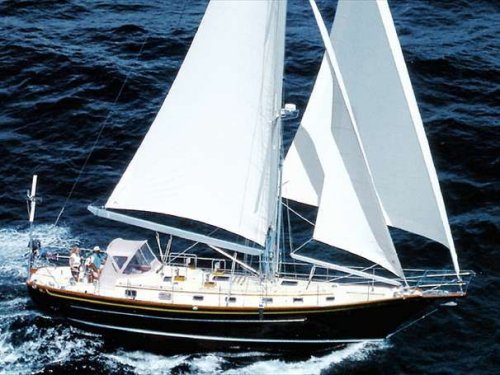
Cabo rico 45 for sale elsewhere on the web:

Main features
| Model | Cabo rico 45 | ||
| Length | 45.01 ft | ||
| Beam | 13.16 ft | ||
| Draft | 5.51 ft | ||
| Country | Costa Rica (north America) | ||
| Estimated price | $ 292800 |
Login or register to personnalize this screen.
You will be able to pin external links of your choice.

See how Sailboatlab works in video
| Sail area / displ. | 19.81 | ||
| Ballast / displ. | 37.92 % | ||
| Displ. / length | 370.68 | ||
| Comfort ratio | 46.79 | ||
| Capsize | 1.60 |
| Hull type | Monohull long keel | ||
| Construction | Fiberglass | ||
| Waterline length | 35.01 ft | ||
| Maximum draft | 5.51 ft | ||
| Displacement | 35604.61 lbs | ||
| Ballast | 13492.27 lbs | ||
| Hull speed | 7.93 knots |

We help you build your own hydraulic steering system - Lecomble & Schmitt
| Rigging | Cutter | ||
| Sail area (100%) | 1333.97 sq.ft | ||
| Air draft | 0 ft | ?? | |
| Sail area fore | 824.95 sq.ft | ||
| Sail area main | 596 sq.ft | ||
| I | 0 ft | ?? | |
| J | 0 ft | ?? | |
| P | 0 ft | ?? | |
| E | 0 ft | ?? |
| Nb engines | 1 | ||
| Total power | 62 HP | ||
| Fuel capacity | 272 gals |
Accommodations
| Water capacity | 168 gals | ||
| Headroom | 0 ft | ||
| Nb of cabins | 2 | ||
| Nb of berths | 6 | ||
| Nb heads | 2 |
Builder data
| Builder | Cabo Rico (CR) | ||
| Designer | William Crealock | ||
| First built | 1995 | ||
| Last built | 0 | ?? | |
| Number built | 8 |
Modal Title
The content of your modal.
Personalize your sailboat data sheet

COMMENTS
Cabo Rico: Related Sailboats: TIBURON 36 : Download Boat Record: Notes. S.A. (reported) above =-Main - 298 sqft-120% Genoa - 519 sqft-Staysail - 152 sqft Sail area with 100% foretriangle is reported as 778 sqft. Later brochures list sail area as: main: 342 sqft + 100% foretriangle: 408 sqft = 750 sqft. ...
Cabo Rico Custom Yachts, Inc. 2258 SE 17th Street Ft. Lauderdale, Florida 33316 Telephone: 954-462-6699 Fax: 954-522-1317 E-Mail: [email protected]. Years in Business: 1967 - present. Sailboats Built By Cabo Rico (CR) (Dates indicate when boat was first built by any builder) Sort by:
The Cabo Rico 38's D/L is 375 and its SA/D is 16.3. This makes the boat moderately heavy, with a mediumsized sailplan—about what you'd expect for a traditional, seakindly ocean cruiser. She has enough power to make decent passage speeds when the wind is up, but she won't be a great light-air performer, especially laden for cruising.
Cabo Rico 38 is a 41′ 0″ / 12.5 m monohull sailboat designed by William Crealock and built by Cabo Rico starting in 1977. ... and from there Cabo Rico Custom Yachts has delivered hulls are a steady clip. In fact for a long time, Cabo Rico was a one-boat manufacturer pumping out the 38 with an incredible variety of configurations. You name ...
A Ballast/Displacement Ratio of 37.1 means that a sailboat like the Cabo Rico 38 (which doesn't have a stiffness-enhancing bulb keel), is likely to benefit from being reefed early to keep her sailing upright in a moderate breeze. 3. A Displacement/Length Ratio of 375, tells us the Cabo Rico 38 is firmly in the ultra-heavy displacement category.
The Cabo rico 38 is a 37.99ft cutter designed by W.I.B. Crealock/Dennis Garrett and built in fiberglass by Cabo Rico (CR) since 1977. 200 units have been built. It accomodates 4 people in 2 cabins plus salon. The Cabo rico 38 is a heavy sailboat which is a high performer. It is stable / stiff and has an excellent righting capability if capsized.
How much do Cabo Rico boats cost? Cabo Rico boats for sale on YachtWorld are offered at a variety of prices from $76,716 on the more modest side, with costs up to $299,500 for the most extravagant model yachts. What Cabo Rico model is the best? Some of the most widely-known Cabo Rico models currently listed include: 38, Northeast 400, 34 and 45.
Find Cabo Rico 38 boats for sale in your area & across the world on YachtWorld. Offering the best selection of Cabo Rico boats to choose from.
The overall length of the Cabo Rico 38 is actually 41-feet due to a three-foot bowsprit. Waterline length is 29' 3"; beam is 11' 6"; draft is listed by the manufacturer at an even five feet; and displacement is 21,500 pounds. The Cabo Rico 38 hull is constructed of fiberglass laminates. Although some balsa core is used in the hull sides ...
Cabo Rico Yachts is a small semi-custom manufacturer of fiberglass sailboats located in Costa Rica and designed by W.I.B. Crealock and Chuck Paine. ... Due to a designer conflict with a similar size boat for a competitor, in 1998 Cabo Rico went to Chuck Paine and Associates of Maine for the new Cabo Rico 40. This was later stretched to a 42 ...
The Cabo rico 34 is a 37.0ft cutter designed by W.I.B. Crealock and built in fiberglass by Cabo Rico (CR) since 1988. The Cabo rico 34 is a very heavy sailboat which is slightly under powered. It is reasonably stable / stiff and has an excellent righting capability if capsized. It is best suited as a bluewater cruising boat.
A boat with a BN of 1.6 or greater is a boat that will be reefed often in offshore cruising. Derek Harvey, "Multihulls for Cruising and Racing", International Marine, Camden, Maine, 1991, states that a BN of 1 is generally accepted as the dividing line between so-called slow and fast multihulls.
Cabo Rico Models. List of All Cabo Rico Models. 38 From 1979 To 1987. 38 Cutter 1989. 42 2002. 56 2003. Chuck Paine 42 2006. Tiburon 36 1977 ©2022 Boats and Yachts Detailed Data And Technical Specs (Dimensions, Prices, Weight and Engine Power) ...
The Cabo rico 38 ph is a 37.99ft cutter designed by W.I.B. Crealock and built in fiberglass by Cabo Rico (CR) since 1976. The Cabo rico 38 ph is a heavy sailboat which is a good performer. It is reasonably stable / stiff and has an excellent righting capability if capsized. It is best suited as a heavy bluewater cruising boat.
New Boat Review: The Cabo Rico 34 Underway / Construction / Conclusion. by Captain Thom Burns. Perhaps the most realistic method to review a cruising yacht is to live on it. When Gunnar of Gunnar's Yacht & Ship suggested staying aboard his new Cabo Rico 34 as part of our review, I thought "Yes, I will get a feel for this yacht, hopefully, as its potential owner will use it."
The Cabo rico 40 - 42 is a 46.5ft cutter designed by C.W. Paine and built in fiberglass by Cabo Rico (CR) since 1998. The Cabo rico 40 - 42 is a heavy sailboat which is a reasonably good performer. It is stable / stiff and has an excellent righting capability if capsized. It is best suited as a bluewater cruising boat. The fuel capacity is average.
17'2' Vandestadt and Mcgruer Siren Snug Harbor Marina Slip 68 5822 Snug Harbor Drive Mayville NY 14757, New York Asking $1,600
30' Etchells 22 Nautical Donations Crowleys Yacht Yard 3434 E 95th St Chicago Il 60617, Illinois Asking $12,000
CABO RICO 40/42. Save to Favorites . Beta Marine. BOTH. US IMPERIAL. METRIC. Sailboat Specifications Definitions Hull Type: Long Keel: Rigging Type: Cutter: LOA: 46.50 ft / 14.17 m ... Cabo Rico: Download Boat Record: Notes. Originally the CR 40, after only a few were built, the stern was stretched and became the CR42. LOD: 42.5 ft Cutter rig ...
Cabo Rico preowned sailboats for sale by owner. Cabo Rico used sailboats for sale by owner.
Blue Water Surf Value Rank (BWSVR) 935. Capsize Comfort Value Rank (CCVR)
The Cabo rico 45 is a 45.01ft cutter designed by William Crealock and built in fiberglass by Cabo Rico (CR) since 1995. 8 units have been built. It accomodates 6 people in 2 cabins plus salon. The Cabo rico 45 is a heavy sailboat which is a good performer. It is stable / stiff and has an excellent righting capability if capsized.